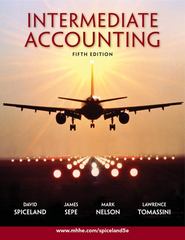can you please answer these questions. Thank you.
Chapter 7, Problem 7-3 A colleague who is aware of your understanding of financial statements asks for help in analyzing the transactions and events of Zett Corporation. The following data are provided: Zett Corporation Balance Sheet December 31, year 1 and Year 2 Cash Accounts Receivable Inventory Investments (long term) ---------Fixed Assets Accumulated depreciation Total Assets Accounts Payable Bonds Payable Common Stock 61,000 Retained Earnings Treasury Stock Total Liabilities and equity Year 1 $34,000 12,000 16,000 Year 2 $34,500 17,000 14,000 6,000 80,000 (48,000) $100,000 $19,000 10,000 50,000 93,000 (39,000) $119,500 $12,000 30,000 21,000 ----------$100,000 28,000 (11,500) $119,500 Additional data for the Period January 1, Year 2, through December 31, Year 2 are: 1. Sales on account, $70,000 2. Purchases on account, $40,000 3. Depreciation 4. Expenses paid in cash $18,000 (including $4,000 of interest and $6,000 in taxes) 5. Decrease in Inventory $2,000 6. Sales of fixed assets for $6,000 cash, cost $21,000 and two thirds depreciated (loss or gain is included in income). 7. Purchase of fixed assets for cash $4,000 8. Fixed Assets are exchanged for bonds payable of $30,000 9. Sale of investments for $9,000 cash 10. Purchase of treasury stock for cash $11,500 11. Retire bonds payable by issuing common stock $10,000 12. Collections on accounts receivable $65,000 13. Sold unissued common stock for cash $1,000 Required: a. Prepare a statement of Cash flows (indirect method) for the year ended December 31, year 2. b. Prepare a side by side comparative statement contrasting two bases of reporting: (1) net income and (2) cash flows from operations. c. Which of the two financial reports in (b) better reflects profitability? Explain Chapter 8, Problems 8-1 1) Determining Return on Invested Capital (conceptual) - Problem 8-1 Quaker Oats, in its annual report discloses the following: Financial Objectives: Provide total shareholder returns (dividends plus share price appreciation) that exceed both the cost of equity and the S&P 500 stock index over time. Quaker's total return to shareholders for Year 11 was 34%. That compares quite favorably to our cost of equity for the year, which was about 12%, and to the total return of the S&P 500 stock index, which was 7%. Driving this strong performance, real earnings from continuing operations grew 7.4% over the last five years, return on equity rose to 24.1%. [Quaker Oats' stock price at the beginning and end of Year 11 was $48 and $62, respectively, and the Year 11 dividends are $1.56 per share.] The Benchmark for Investment We use our cost of capital as a benchmark, or hurdle rate, to ensure that all projects undertaken promise a suitable rate of return. The cost of capital is used as the discount rate in determining whether a project will provide an economic return on its investment. We estimate a project's potential cash flows and discount these cash flows back to present value. This amount is compared with the initial investment costs to determine whether incremental value is created. Our cost of capital is calculated using the approximate market value weightings of debt and equity used to finance the Company. Cost of equity + Cost of debt = Cost of capital When Quaker is consistently able to generate and reinvest cash flows in projects whose returns exceed our cost of capital, economic value is created. As the stock market evaluates the Company's ability to generate value, this value is reflected in stock price appreciation. The cost of equity. The cost of equity is a measure of the minimum return Quaker must earn to properly compensate investors for the risk of ownership of our stock. This cost is a combination of a "risk-free" rate and an "equity risk premium." The risk-free rate (the U.S. Treasury Bond rate) is the sum of the expected rate of inflation and a "real" return of 2 to 3%. For Year 11, the risk-free rate was approximately 8.4%. Investors in Quaker stock expect the return of a risk-free security plus a "risk premium" of about 3.6% to compensate them for assuming the risks in Quaker stock. The risk in holding Quaker stock is inherent in the fact that returns depend on the future profitability of the Company. Quaker's cost of equity was approximately 12%. The cost of debt. The cost of debt is simply our after-tax, long-term debt rate, which was around 6.4%. Required: a. Quaker reports the \"return to shareholders\" to be 34% (1) How is this return computed (provide calculations)? (2) How is this return different from return on common equity? b. Explain how Quaker oats arrives at a 3.6% \"risk premium\" needed by common shareholders as compensation Problem 8-3 Selected income statement and balance sheet data from Merck & Co. for Year 9 are reproduced below: MERCK & COMPANY, INC. Year 9 Selected Financial Data ($ millions) Income Statement Data $7,120 230 10 2,550 900 1650 Sales revenue Depreciation Interest expense Pretax income Income taxes Net income Balance Sheet Data Current assets Fixed assets, net Total assets Current liabilities Long-term debt Shareholders' equity Total liabilities & shareholders' equity $4,850 2,400 7,250 3,290 100 3,860 7,250 a. Calculate return on common equity for Year 9 using year-end amounts and assuming no preferred dividends. b. Disaggregate Merck's ROCE into operating (RNOA) and nonoperating components. Comment on Merck's use of leverage. (Assume all assets and current liabilities are operating and a 35% tax rate.)







